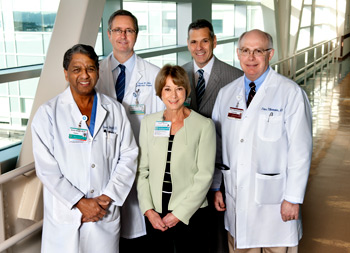 At Lifespan hospitals, the safety and well being of our patients comes first. We accomplish this by offering the best care to our patients and by putting systems into place that further protect you from medical errors, minimizing the risks of wrong site surgeries, infections, and other adverse outcomes that might arise. General information about safety initiatives at Lifespan hospitals
At Lifespan hospitals, the safety and well being of our patients comes first. We accomplish this by offering the best care to our patients and by putting systems into place that further protect you from medical errors, minimizing the risks of wrong site surgeries, infections, and other adverse outcomes that might arise. General information about safety initiatives at Lifespan hospitals
Specific Initiatives at Lifespan
Choose an area below to learn more about our specific safety efforts:
- Monitoring, Reporting and Preventing Errors
We require that our staff be responsible and accountable for their actions; address and report safety risks of any sort; and work individually and collaboratively to prevent errors.
- Keeping Patients Infection-Free
All hospital employees adhere to a proactive program that has decreased patients’ risk of infections.
- Closing the Loop on Medication Safety
Our end-to-end automated medication dispensing system reduces human error and increases patient safety.
- Keeping Patients Safe Before, During and After Surgery
Our multidisciplinary surgical teams adhere to strict procedures that help ensure that a patient’s experience is safe before, during and after surgery.
- Promoting Patient Safety through Nursing Initiatives
The nursing staff at our hospitals have the education, experience and skills needed to help each patient’s steady progress toward healing and health.
- Training Doctors and Nurses at the Lifespan Medical Simulation Center
The Lifespan Medical Simulation Center is a custom designed and built 3,000-square-foot training and assessment facility. Medical personnel from Lifespan’s hospitals and from the local, national and international medical community come to the center’s classrooms to master medical technologies and techniques in order to improve outcomes and to ensure patient safety. Surgical teams and emergency department teams train to perfect communication among the team members and ensure that they work seamlessly.
- Offering Exemplary Cardiac Care
At our hospitals, physicians, nurses, technicians and hospital administrative staff work as a team to provide patients with outstanding surgical, medical and critical cardiac care.
- Reducing ICU-Related Complications for the Critically Ill
Our hospitals and the Rhode Island ICU Collaborative have joined forces to significantly reduce ICU-related complications.
- Keeping Young Patients Safe
Our hospitals provide the highest quality medical care to our youngest patients and our staff is dedicated to keeping our patients safe while they are getting well.
- Practicing Radiation Safety for Patients
All Lifespan hospitals adhere to strict federal and state government regulations regarding the use of radiation for health care and research.
- Reducing Human Error in Systems and Work Environments
We use the latest advances in technological systems to monitor our patients’ health and to ensure that they receive the safest quality care. We also strive to ensure that our work environments are designed and kept safe at all times for patients, staff and visitors.
- Designing Our Facilities to Maintain Patient Safety
The maintenance and modernization of all facilities is supervised and conducted by an in-house department of licensed professional designers; architects; mechanical, electrical, and fire protection engineers; and project managers. These experts are charged with ensuring that all of our hospital facilities are designed and engineered properly, from the initial design phase to the finished project, with the primary focus on creating safe patient environments.
- Investing in Technology That Supports Patient Safety
Lifespan’s investment in cutting-edge technology that supports patient safety has earned Lifespan a national reputation for being at the forefront of technology in health care.
Find out more